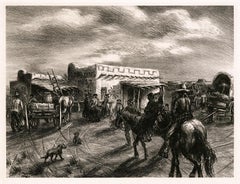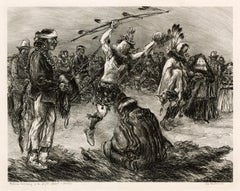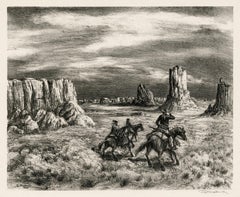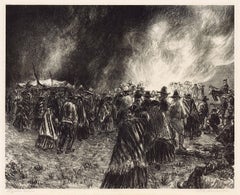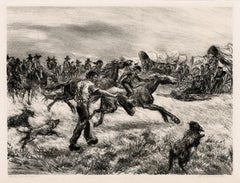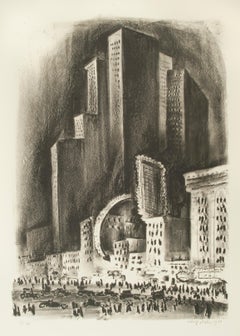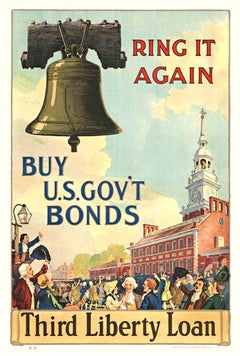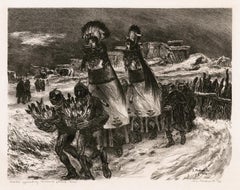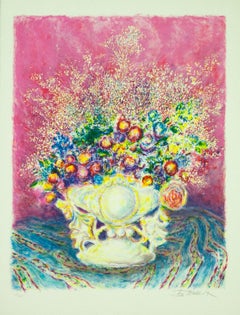Ira Moskowitz Art
to
1
11
8
2
8
2
Overall Height
to
Overall Width
to
5
2
1
8
5
4
3
2
2
1
1
1
1
1
1
1
1
1
1
11
7
11
6,996
3,348
2,513
1,213
10
1
Artist: Ira Moskowitz
'Navajo Trading Post' — 1940s Southwest Regionalism
By Ira Moskowitz
Located in Myrtle Beach, SC
Ira Moskowitz, 'Navajo Trading Post', lithograph, 1946, edition 30, Czestochowski 161. Signed and dated in the stone, lower left. A fine, richly-inked impression, on cream wove paper, with full margins (1 1/2 to 3 1/8 inches). Pale mat line, otherwise in excellent condition. Matted to museum standards, unframed.
Image size 11 11/16 x 15 1/2 inches (297 x 395 mm); sheet size 16 5/16 x 191/8 inches (414 x 486 mm).
ABOUT THE ARTIST
Ira Moskowitz was born in Galicia, Poland, in 1912, emigrating with his family to New York in 1927. He enrolled at the Art Student's League and studied there from 1928-31. In 1935, Moskowitz traveled to Paris and then lived until 1937 in what is now Israel. He returned to the United States in 1938 to marry artist Anna Barry in New York. The couple soon visited Taos and Santa Fe in New Mexico, returning for extended periods until 1944, when they moved there permanently, staying until 1949. During this especially productive New Mexico period, Moskowitz received a Guggenheim fellowship. His work was inspired by the New Mexico landscape and the state’s three cultures (American Southwest, Native American, and Mexican). He focused on Pueblo and Navajo life, producing an extensive oeuvre of authentic American Indian imagery. He and Anna also visited and sketched across the border in Old Mexico. While in the Southwest, Moskowitz flourished as a printmaker while continuing to produce oils and watercolors. Over 100 of Moskowitz’s works depicting Native American ceremonies were used to illustrate the book American Indian Ceremonial Dances by John Collier, Crown Publishers, New York, 1972.
After leaving the Southwest, printmaking remained an essential medium for the artist while his focus changed to subject matter celebrating Judaic religious life and customs. These works were well received early on, and Moskowitz was content to stay with them the rest of his life. From 1963 until 1966, Moskowitz lived in Paris, returning to New York City in 1967, where he made his permanent home until he died in 2001.
Shortly before his death, Zaplin-Lampert Gallery of Santa Fe staged an exhibition of the artist's works, December 2000 - January 2001. Other one-person shows included the 8th Street Playhouse, New York, 1934; Houston Museum, 1941; and the San Antonio Museum, 1941. The artist’s work was included in exhibitions at the Art Students League, Art Institute of Chicago, Philadelphia Print Club, College Art Association (promotes excellence in scholarship and teaching), and the International Exhibition of Graphic Arts (shown at MOMA, 1955).
Moskowitz’s lithographs of American Indian...
Category
1940s American Modern Ira Moskowitz Art
Materials
Lithograph
'Navajo Medicine Ceremony of the Night Chant' — 1940s Southwest Regionalism
By Ira Moskowitz
Located in Myrtle Beach, SC
Ira Moskowitz, 'The Three Gods of Healing (Navajo Medicine Ceremony of the Night Chant)', lithograph, 1945, edition 30, Czestochowski 148. Signed and titled in pencil. Signed and dated in the stone, lower right. A fine, richly-inked impression, on cream wove paper, with full margins (2 1/4 to 2 3/4 inches), in excellent condition. Matted to museum standards, unframed.
Image size 12 1/4 x 15 13/16 inches (311 x 402 mm); sheet size 17 1/8 x 20 7/8 inches (435 x 530 mm).
ABOUT THIS WORK
The nine-night ceremony known as the Night Chant or Nightway is believed to date from around 1000 B.C.E. when it was first performed by the Indians who lived in Canyon de Chelly (now eastern Arizona). It is considered the most sacred of all Navajo ceremonies and one of the most difficult and demanding to learn, as it encompasses hundreds of songs, dozens of prayers, and several highly complex sand paintings. And yet the demand for Night Chants is so great that as many as fifty such ceremonies might be held during a single winter season, which lasts eighteen to twenty weeks.
The Night Chant is designed both to cure people who are ill and to restore the order and balance of human and non-human relationships within the Navajo universe. Led by a trained medicine man who has served a long apprenticeship and learned the intricate and detailed practices that are essential to the chant, the ceremony itself is capable of scaring off sickness and ugliness through techniques that shock or arouse. Once the disorder has been removed, order and balance are restored through song, prayer, sand painting, and other aspects of the ceremony.
The medicine men who supervise the Night Chant ensure that everything—each dot and line in every sand painting, each verse in every song, each feather on each mask is arranged precisely, or it will not bring about the desired result. There are probably as many active Night Chant medicine men today as at any time in Navajo history due to the general increase in the Navajo population, the popularity of the ceremony, and the central role it plays in Navajo life and health.
ABOUT THE ARTIST
Ira Moskowitz was born in Galicia, Poland, in 1912, emigrating with his family to New York in 1927. He enrolled at the Art Student's League and studied there from 1928-31. In 1935, Moskowitz traveled to Paris and then lived until 1937 in what is now Israel. He returned to the United States in 1938 to marry artist Anna Barry in New York. The couple soon visited Taos and Santa Fe in New Mexico, returning for extended periods until 1944, when they moved there permanently, staying until 1949. During this especially productive New Mexico period, Moskowitz received a Guggenheim fellowship. His work was inspired by the New Mexico landscape and the state’s three cultures (American Southwest, Native American, and Mexican). He focused on Pueblo and Navajo life, producing an extensive oeuvre of authentic American Indian imagery. He and Anna also visited and sketched across the border in Old Mexico. While in the Southwest, Moskowitz flourished as a printmaker while continuing to produce oils and watercolors. Over 100 of Moskowitz’s works depicting Native American ceremonies were used to illustrate the book American Indian Ceremonial Dances by John Collier, Crown Publishers, New York, 1972.
After leaving the Southwest, printmaking remained an essential medium for the artist while his focus changed to subject matter celebrating Judaic religious life and customs. These works were well received early on, and Moskowitz was content to stay with them the rest of his life. From 1963 until 1966, Moskowitz lived in Paris, returning to New York City in 1967, where he made his permanent home until he died in 2001.
Shortly before his death, Zaplin-Lampert Gallery of Santa Fe staged an exhibition of the artist's works, December 2000 - January 2001. Other one-person shows included the 8th Street Playhouse, New York, 1934; Houston Museum, 1941; and the San Antonio Museum, 1941. The artist’s work was included in exhibitions at the Art Students League, Art Institute of Chicago, Philadelphia Print Club, College Art Association (promotes excellence in scholarship and teaching), and the International Exhibition of Graphic Arts (shown at MOMA, 1955).
Moskowitz’s lithographs of...
Category
1940s American Modern Ira Moskowitz Art
Materials
Lithograph
'Navajo Reservation Landscape' — 1940s Southwest Regionalism
By Ira Moskowitz
Located in Myrtle Beach, SC
Ira Moskowitz, 'Navajo Reservation Landscape', lithograph, 1945, edition c. 30. Signed and titled in pencil. Signed and dated in the stone, lower left. A fine, richly-inked impression, on cream wove paper, the full sheet with margins (1 3/8 to 2 inches), in excellent condition. Matted to museum standards, unframed.
Image size 12 3/4 x 15 3/4 inches (324 x 400 mm); sheet size: 15 1/2 x 19 inches (394 x 482 mm).
ABOUT THE ARTIST
Ira Moskowitz was born in Galicia, Poland, in 1912, emigrating with his family to New York in 1927. He enrolled at the Art Student's League and studied there from 1928-31. In 1935, Moskowitz traveled to Paris and then lived until 1937 in what is now Israel. He returned to the United States in 1938 to marry artist Anna Barry in New York. The couple soon visited Taos and Santa Fe in New Mexico, returning for extended periods until 1944, when they moved there permanently, staying until 1949. During this especially productive New Mexico period, Moskowitz received a Guggenheim fellowship. His work was inspired by the New Mexico landscape and the state’s three cultures (American Southwest, Native American, and Mexican). He focused on Pueblo and Navajo life, producing an extensive oeuvre of authentic American Indian imagery. He and Anna also visited and sketched across the border in Old Mexico. While in the Southwest, Moskowitz flourished as a printmaker while continuing to produce oils and watercolors. Over 100 of Moskowitz’s works depicting Native American ceremonies were used to illustrate the book American Indian Ceremonial Dances by John Collier, Crown Publishers, New York, 1972.
After leaving the Southwest, printmaking remained an essential medium for the artist while his focus changed to subject matter celebrating Judaic religious life and customs. These works were well received early on, and Moskowitz was content to stay with them the rest of his life. From 1963 until 1966, Moskowitz lived in Paris, returning to New York City in 1967, where he made his permanent home until he died in 2001.
Shortly before his death, Zaplin-Lampert Gallery of Santa Fe staged an exhibition of the artist's works, December 2000 - January 2001. Other one-person shows included the 8th Street Playhouse, New York, 1934; Houston Museum, 1941; and the San Antonio Museum, 1941. The artist’s work was included in exhibitions at the Art Students League, Art Institute of Chicago, Philadelphia Print Club, College Art Association (promotes excellence in scholarship and teaching), and the International Exhibition of Graphic Arts (shown at MOMA, 1955).
Moskowitz’s lithographs of American Indian...
Category
1940s Ira Moskowitz Art
Materials
Lithograph
'Navajo Courtship Dance' — 1940s Southwest Regionalism
By Ira Moskowitz
Located in Myrtle Beach, SC
Ira Moskowitz, 'Navajo Courtship Dance (Squaw Dance)', lithograph, 1946, edition 30, Czestochowski 161. Signed and titled in pencil. Signed and dated in the stone, lower left. A fine, richly-inked impression, on cream wove paper; the full sheet with margins (7/16 to 2 3/4 inches). Pale mat line, otherwise in excellent condition. Matted to museum standards, unframed.
Image size 11 13/16 x 14 13/16 inches (300 x 376 mm); sheet size 13 1/16 x 20 1/8 inches (332 x 511 mm).
ABOUT THE ARTIST
Ira Moskowitz was born in Galicia, Poland, in 1912, emigrating with his family to New York in 1927. He enrolled at the Art Student's League and studied there from 1928-31. In 1935, Moskowitz traveled to Paris and then lived until 1937 in what is now Israel. He returned to the United States in 1938 to marry artist Anna Barry in New York. The couple soon visited Taos and Santa Fe in New Mexico, returning for extended periods until 1944, when they moved there permanently, staying until 1949. During this especially productive New Mexico period, Moskowitz received a Guggenheim fellowship. His work was inspired by the New Mexico landscape and the state’s three cultures (American Southwest, Native American, and Mexican). He focused on Pueblo and Navajo life, producing an extensive oeuvre of authentic American Indian imagery. He and Anna also visited and sketched across the border in Old Mexico. While in the Southwest, Moskowitz flourished as a printmaker while continuing to produce oils and watercolors. Over 100 of Moskowitz’s works depicting Native American ceremonies were used to illustrate the book American Indian Ceremonial Dances by John Collier, Crown Publishers, New York, 1972.
After leaving the Southwest, printmaking remained an essential medium for the artist while his focus changed to subject matter celebrating Judaic religious life and customs. These works were well received early on, and Moskowitz was content to stay with them the rest of his life. From 1963 until 1966, Moskowitz lived in Paris, returning to New York City in 1967, where he made his permanent home until he died in 2001.
Shortly before his death, Zaplin-Lampert Gallery of Santa Fe staged an exhibition of the artist's works, December 2000 - January 2001. Other one-person shows included the 8th Street Playhouse, New York, 1934; Houston Museum, 1941; and the San Antonio Museum, 1941. The artist’s work was included in exhibitions at the Art Students League, Art Institute of Chicago, Philadelphia Print Club, College Art Association (promotes excellence in scholarship and teaching), and the International Exhibition of Graphic Arts (shown at MOMA, 1955).
Moskowitz’s lithographs of...
Category
1940s American Modern Ira Moskowitz Art
Materials
Lithograph
'Taos - Relic of the Insurrection of 1845' — 1940s Southwest Regionalism
By Ira Moskowitz
Located in Myrtle Beach, SC
Ira Moskowitz, 'Relic of the Insurrection of 1845' also 'Taos Pueblo with Ruin)', lithograph, 1944, edition 30, Czestochowski 121. Signed and titled in pencil. Signed and dated in the stone, lower right. A fine, richly-inked impression, on cream wove paper, with full margins (1 3/8 to 1 15/16 inches). Very pale light toning within a previous mat opening, otherwise in excellent condition. Matted to museum standards, unframed.
Image size 11 5/8 x 15 1/2 inches (296 x 394 mm); sheet size 15 1/8 x 19 inches (384 x 483 mm).
ABOUT THE IMAGE
The Taos Revolt was a populist insurrection in January 1847 by Hispano and Pueblo allies against the United States occupation of present-day northern New Mexico during the Mexican–American War. The rebels killed provisional governor Charles Bent and several other Americans. In two short campaigns, United States troops and militia crushed the rebellion of the Hispano and Pueblo people. The New Mexicans, seeking better representation, regrouped and fought three more engagements, but after being defeated, they abandoned open warfare. The hatred of New Mexicans for the occupying American army, combined with the rebelliousness of Taos residents against imposed outside authority, were causes of the revolt. In the uprising's aftermath, the Americans executed at least 28 rebels. The Treaty of Guadalupe Hidalgo in 1850 guaranteed the property rights of New Mexico's Hispanic and American Indian residents.
ABOUT THE ARTIST
Ira Moskowitz was born in Galicia, Poland, in 1912, emigrating with his family to New York in 1927. He enrolled at the Art Student's League and studied there from 1928-31. In 1935, Moskowitz traveled to Paris and then lived until 1937 in what is now Israel. He returned to the United States in 1938 to marry artist Anna Barry in New York. The couple soon visited Taos and Santa Fe in New Mexico, returning for extended periods until 1944, when they moved there permanently, staying until 1949. During this especially productive New Mexico period, Moskowitz received a Guggenheim fellowship. His work was inspired by the New Mexico landscape and the state’s three cultures (American Southwest, Native American, and Mexican). He focused on Pueblo and Navajo life, producing an extensive oeuvre of authentic American Indian imagery. He and Anna also visited and sketched across the border in Old Mexico. While in the Southwest, Moskowitz flourished as a printmaker while continuing to produce oils and watercolors. Over 100 of Moskowitz’s works depicting Native American ceremonies were used to illustrate the book American Indian Ceremonial Dances by John Collier, Crown Publishers, New York, 1972.
After leaving the Southwest, printmaking remained an essential medium for the artist while his focus changed to subject matter celebrating Judaic religious life and customs. These works were well received early on, and Moskowitz was content to stay with them the rest of his life. From 1963 until 1966, Moskowitz lived in Paris, returning to New York City in 1967, where he made his permanent home until he died in 2001.
Shortly before his death, Zaplin-Lampert Gallery of Santa Fe staged an exhibition of the artist's works, December 2000 - January 2001. Other one-person shows included the 8th Street Playhouse, New York, 1934; Houston Museum, 1941; and the San Antonio Museum, 1941. The artist’s work was included in exhibitions at the Art Students League, Art Institute of Chicago, Philadelphia Print Club, College Art Association (promotes excellence in scholarship and teaching), and the International Exhibition of Graphic Arts (shown at MOMA, 1955).
Moskowitz’s lithographs of American Indian...
Category
1940s American Modern Ira Moskowitz Art
Materials
Lithograph
'Navajo Horse Race' — 1940s Southwest Regionalism
By Ira Moskowitz
Located in Myrtle Beach, SC
Ira Moskowitz, 'Navajo Horse Race', lithograph, 1946, edition 30, Czestochowski 204. Signed and titled in pencil. Signed and dated in the stone, lower le...
Category
1940s American Modern Ira Moskowitz Art
Materials
Lithograph
Judaica interior scene etching with hand coloring
By Ira Moskowitz
Located in Surfside, FL
I believe the scene is of a wedding engagement. etching with extensive hand coloring (making it a unique original work of art)
Ira Moskowitz (1912-2001), descendant of a long rabbinical line, was born in Galicia Poland and went with his family to Prague, Czechoslovakia, in 1914. The family remained there until 1927, and young Moskowitz received his first education in Prague's schools. Soon after, his family moved to New York City, and in 1927 Moskowitz became the pupil of Henry Wickey at the Art Students League, having finally resolved his conflict between a passion for drawing and a desire to follow the rabbinical profession of his forefathers. Between 1935 and 1938, he traveled to Israel and to Europe, Paris, France where he studied the works of the old masters, an interest derived from his first teacher and one that eventually led to his active collaboration in 1954 on the four-volume series, "Great Drawings of All Time."
In 1939, Moskowitz made his first trip to Mexico, and stayed for six months. In 1943 he received a Guggenheim Fellowship and moved to New Mexico, where he remained for seven years drawing the Indians and becoming an active member of the Taos-Sante Fe artists group. It was in New York, as a student of Harry Wickey and Jerome Meyers at the Art Students League ( 1928 -32), that Moskowitz honed his talents as an artist. In the mid-to-late 1930s in Mexico, Ira was drawn to the traditions of the native peoples; in Israel, what was then British MandatePalestine he was absorbed with the religious ceremonies of the Hasidic Jews. The prints and drawings Moskowitz created in Mexico in 1941 earned him a Guggenheim Fellowship in 1943.
In 1944, Ira and his wife, the artist Anna Barry moved to Taos, New Mexico. Moskowitz was entranced by New Mexico's light, landscapes, and cultures. By the time Ira arrived there, the region had already attracted Georgia O'Keeffe, Robert Henri, and Leon Gaspard...
Category
20th Century Post-Impressionist Ira Moskowitz Art
Materials
Lithograph
Floral Still Life
By Ira Moskowitz
Located in Mount Vernon, NY
Signed vintage lithograph of a floral still life by Polish-born Ira Moskowitz (1912 - 2001), who emigrated at the age of 15 from Europe to New York where ...
Category
Late 20th Century Ira Moskowitz Art
Materials
Lithograph
Judaica interior scene etching with hand coloring
By Ira Moskowitz
Located in Surfside, FL
Etching with extensive hand coloring (making it a unique original work of art)
Ira Moskowitz (1912-2001), descendant of a long rabbinical line, was born in Galicia Poland and went with his family to Prague, Czechoslovakia, in 1914. The family remained there until 1927, and young Moskowitz received his first education in Prague's schools. Soon after, his family moved to New York City, and in 1927 Moskowitz became the pupil of Henry Wickey at the Art Students League, having finally resolved his conflict between a passion for drawing and a desire to follow the rabbinical profession of his forefathers. Between 1935 and 1938, he traveled to Israel and to Europe, Paris, France where he studied the works of the old masters, an interest derived from his first teacher and one that eventually led to his active collaboration in 1954 on the four-volume series, "Great Drawings of All Time."
In 1939, Moskowitz made his first trip to Mexico, and stayed for six months. In 1943 he received a Guggenheim Fellowship and moved to New Mexico, where he remained for seven years drawing the Indians and becoming an active member of the Taos-Sante Fe artists group. It was in New York, as a student of Harry Wickey and Jerome Meyers at the Art Students League ( 1928 -32), that Moskowitz honed his talents as an artist. In the mid-to-late 1930s in Mexico, Ira was drawn to the traditions of the native peoples; in Israel, what was then British MandatePalestine he was absorbed with the religious ceremonies of the Hasidic Jews. The prints and drawings Moskowitz created in Mexico in 1941 earned him a Guggenheim Fellowship in 1943.
In 1944, Ira and his wife, the artist Anna Barry moved to Taos, New Mexico. Moskowitz was entranced by New Mexico's light, landscapes, and cultures. By the time Ira arrived there, the region had already attracted Georgia O'Keeffe, Robert Henri, and Leon Gaspard...
Category
20th Century Post-Impressionist Ira Moskowitz Art
Materials
Etching
Street Musicians by Ira Moskowitz original lithograph
By Ira Moskowitz
Located in Paonia, CO
Street Musicians by Ira Moskowitz shows four musicians playing various horn instruments including trumpets and trombones. Behind them some childre...
Category
20th Century Expressionist Ira Moskowitz Art
Materials
Lithograph
Mountain Scene
By Ira Moskowitz
Located in New York, NY
Ira Moskowitz (1912-1985), [Mountain Scene], 1943, lithograph, signed in pencil lower right, numbered lower left (27/50) [also signed and dated 1943 in ...
Category
1940s American Realist Ira Moskowitz Art
Materials
Lithograph
Related Items
New York Night
By Adolf Dehn
Located in Fairlawn, OH
New York Night\Lithograph, 1930
Edition: 30
Printer: Meister Schulz, Berlin
Printed on heavy wove paper without watermark
This lithograph was created in...
Category
1930s American Modern Ira Moskowitz Art
Materials
Lithograph
Original "Ring It Again, Third Liberty Loan vintage WW1 poster
Located in Spokane, WA
Original poster: Ring it Again Third Liberty Loan. Buy U. S. Gov't Bonds. World War 1 lithograph poster over 100 years old. It is mounted on acid-free archival linen. It looks l...
Category
1920s American Modern Ira Moskowitz Art
Materials
Lithograph
Original "Speedy Travel, German Federal Railroad" vintage travel poster, train
Located in Spokane, WA
Original “Speedy Travel, German Federal Railroad” vintage travel poster. The DB stands for the Deutsche Bundesbahn. Archivally linen-backed in very good condition and ready to fra...
Category
1950s American Modern Ira Moskowitz Art
Materials
Lithograph
H 33 in W 23.5 in D 0.05 in
Prodigal Son
By Thomas Hart Benton
Located in London, GB
A fine impression with full margins published by Associated American Artists with their information label present - pictured in Art and Popular Religion in Evangelical America, 1815-...
Category
1930s American Modern Ira Moskowitz Art
Materials
Lithograph
Original "Back Our Girls Over There, YWCA vintage WW1 poster
By Clarence Underwood
Located in Spokane, WA
Original Back Our Girls Over There Y.W.C.A. WW1 antique poster: Linen-backed original Beautiful Y.W.C.A. Telephone operator sitting at the control pane...
Category
1910s American Modern Ira Moskowitz Art
Materials
Lithograph
H 28 in W 21.5 in D 0.05 in
Nebraska Evening
By Thomas Hart Benton
Located in London, GB
A fine impression with good margins published by Associated American Artists.
Category
1940s American Modern Ira Moskowitz Art
Materials
Lithograph
Arc de Triomphe in Snow (Napoleon's Triumphal Arch)
By Ellison Hoover
Located in Storrs, CT
Arc de Triomphe in Snow (Napoleon's Triumphal Arch). c. 1930. Lithograph printed in grey ink. 11 1/4 x 9 7/16 (sheet 16 x 12). A tonal impression printe...
Category
1930s American Modern Ira Moskowitz Art
Materials
Lithograph
Approaching Storm
By Richard Florsheim
Located in New York, NY
Richard Florsheim created this color lithograph entitled “Approaching Storm” in 1967 in an edition of 125 pieces. Published by Associated American Artists and printed by Mourlot Press, Paris, this impression is signed and inscribed “Artist Proof.” It is in good condition with full original color. The printed image size is 28.25 x 19 3/4 inches and the paper size is 31.12 x 22 inches.
RICHARD ABERLE...
Category
1960s American Modern Ira Moskowitz Art
Materials
Lithograph
Niagara Falls
By Adolf Arthur Dehn
Located in Fairlawn, OH
Niagara Falls
Lithograph, 1931
Signed lower right (see photo)
Titled/edition lower left. (see photo)
Edition of 25
Provenance: the Estate of the Artist
Condition: Excellent
Image si...
Category
1930s American Modern Ira Moskowitz Art
Materials
Lithograph
Mine Near Continental Divide, Black White Colorado Mountain Landscape Winter
By Arnold Rönnebeck
Located in Denver, CO
Lithograph on paper titled 'Mine Near Continental Divide' by Arnold Ronnebeck (1885-1947) from 1933. Depicts a black and white winter scene of a mine in the mountains with snow on the rooftops and hillsides. Presented in a custom frame measuring 18 ¼ x 22 ¼ inches. Image size measures 10 ¼ x 14 ½ inches.
Provenance: Estate of the Artist, Arnold Ronnebeck
Expedited and international shipping is available - please contact us for a quote.
About the Artist:
Modernist sculptor, lithographer and museum administrator, Rönnebeck was a noted member of European and American avant-garde circles in the early twentieth century before settling in Denver, Colorado, in 1926.
After studying architecture at the Royal Art School in Berlin for two years beginning in 1905, he moved to Paris in 1908 to study sculpture with Aristide Maillol and Émile-Antoine Bourdelle. While there he met and befriended American modernist painter, Marsden Hartley, of whom he sculpted a bronze head that was exhibited at the Salon d’Automne in Paris in 1912 and the following year at Hartley’s solo show of paintings at Alfred Stieglitz’s Gallery 291 in New York. A frequent guest of Gertrude Stein’s Saturday "evenings" in Paris, she described Rönnebeck as "charming and always invited to dinner," along with Pablo Picasso, Mabel Dodge (Luhan) and Charles Demuth.
After the outbreak of World War I in 1914, Rönnebeck returned to Germany where he served as an officer in the German Imperial Army on the front lines. Twice wounded, including in the Battle of Marne in France, Kaiser Wilhelm II awarded him the Iron Cross. During the war Hartley fell in love with Rönnebeck’s cousin, Lieutenant Karl von Freyburg, who was killed in combat. As a tribute to Freyburg, Hartley created Portrait of a German Officer (1914) now in the Metropolitan Museum of Art in New York.
After the war Rönnebeck traveled in Italy with German writer, Max Sidow, and German poet, Theodor Daubler, doing a series of drawings of Positano and the Amalfi Coast that formed the basis for his lithographs on the subject. The death of his finacée, the young American opera singer Alice Miriam in 1922 and his own family’s increasing financial problems in post-World War I Germany led him to immigrate to the United States in 1923. After living briefly with Miriam’s family in Washington, DC, he moved to New York where he became part of the avant-garde circle around Alfred Stieglitz. His essay, "Through the Eyes of a European Sculptor," appeared in the catalog for the Anderson Gallery exhibition, "Alfred Stieglitz Presents Seven Americans: 159 Paintings, Photographs & Things, Recent & Never Publicly Shown, by Arthur G. Dove, Marsden Hartley, John Marin, Charles Demuth, Paul Strand, Georgia O’Keeffe, Alfred Stieglitz."
In New York Rönnebeck began producing Precisionist-style lithographs of the city’s urban landscapes which he termed "living cubism." Some of them were reproduced in Vanity Fair magazine. Through Stieglitz he met Erhard Weyhe head of the Weyhe Gallery who, with its director Carl Zigrosser, arranged Rönnebeck’s first solo American exhibition in May 1925 at the gallery in New York. Comprising some sixty works – prints, drawings and sculpture – the show subsequently traveled on a thirteen-month tour of major American cities. Until the end of his life, the gallery represented him, along with other American artists Adolf Dehn, Wanda Gag, Rockwell Kent, J.J. Lankes, Louis Lozowick, Reginald Marsh and John Sloan.
In the summer of 1925, as the guest of Mabel Dodge Luhan, Rönnebeck first saw Taos, New Mexico, which Marsden Hartley had encouraged him to visit. It was there that he met his future wife, Louise Emerson, an easel painter and muralist. A year later they were married in New York before relocating to Denver. He served as director of the Denver Art Museum from 1926 to 1930 where he invited Marsden Hartley to lecture on Cézanne’s art in 1928. Rönnebeck fostered the development of the museum’s collection of American Indian art and the curation of modernist art exhibitions. In addition to his work at the museum, he was professor of sculpture at the University of Denver’s College of Fine and Applied Arts from 1929 to 1935, and wrote a weekly art column in the Rocky Mountain News.
His best known Denver sculptures from the late 1920s in bronze, copper, stone, wood and terra cotta include a reredos, The Epiphany, at St. Martin’s Chapel; The History of Money (six panels) at the Denver National Bank; The Ascension at the Church of Ascension; and the William V. Hodges Family Memorial at Fairmount Cemetery. At the same time he did a series of terra cotta relief panels for La Fonda Hotel in Santa Fe, New Mexico. In the 1930s his bas-relief aluminum friezes of stylized Pueblo and Hopi Indian Kachina masks...
Category
1930s American Modern Ira Moskowitz Art
Materials
Lithograph, Paper
H 18.25 in W 22.25 in D 0.75 in
Carnival
By Richard Florsheim
Located in New York, NY
Richard Florsheim created this color lithograph entitled “Carnival” in 1972 in an edition of 30 pieces. Published by Associated American Artists and printed by Landfall Press, this i...
Category
1970s American Modern Ira Moskowitz Art
Materials
Lithograph
Brooklyn Waterfront
By Adolf Arthur Dehn
Located in Fairlawn, OH
Brooklyn Waterfront
Lithograph, 1931
Signed, titled, and dated in pencil by the artist
Edition: Undetermined (very small), plus artist's proofs
Printed by Meister Schulz, Berlin
Provenance:
Estate of the artist
Virginia Dehn, the artist's widow
Dehn Quests
Bibliography:
Lumsdaine and O'Sullivan 152
Illustrated: Adams, The Sensuous Life of Adolf Dehn, Fig. 9.14, page 213 (This impression)
Adolf Dehn, American Watercolorist and Printmaker, 1895-1968
Adolf Dehn was an artist who achieved extraordinary artistic heights, but in a very particular artistic sphere—not so much in oil painting as in watercolor and lithography. Long recognized as a master by serious print collectors, he is gradually gaining recognition as a notable and influential figure in the overall history of American art.
In the 19th century, with the invention of the rotary press, which made possible enormous print runs, and the development of the popular, mass-market magazines, newspaper and magazine illustration developed into an artistic realm of its own, often surprisingly divorced from the world of museums and art exhibitions, and today remains surprisingly overlooked by most art historians. Dehn in many regards was an outgrowth of this world, although in an unusual way, since as a young man he produced most of his illustrative work not for popular magazines, such as The Saturday Evening Post, but rather for radical journals, such as The Masses or The Liberator, or artistic “little magazines” such as The Dial. This background established the foundation of his outlook, and led later to his unique and distinctive contribution to American graphic art.
If there’s a distinctive quality to his work, it was his skill in introducing unusual tonal and textural effects into his work, particularly in printmaking but also in watercolor. Jackson Pollock seems to have been one of many notable artists who were influenced by his techniques.
Early Years, 1895-1922
For an artist largely remembered for scenes of Vienna and Paris, Adolf Dehn’s background was a surprising one. Born in Waterville, Minnesota, on November 22, 1895, Dehn was the descendent of farmers who had emigrated from Germany and homesteaded in the region, initially in a one-room log cabin with a dirt floor. Adolf’s father, Arthur Clark Dehn, was a hunter and trapper who took pride that he had no boss but himself, and who had little use for art. Indeed, during Adolf’s boyhood the walls of his bedroom and the space under his bed were filled with the pelts of mink, muskrats and skunks that his father had killed, skinned and stretched on drying boards. It was Adolf’s mother, Emilie Haas Dehn, a faithful member of the German Lutheran Evangelical Church, who encouraged his interest in art, which became apparent early in childhood. Both parents were ardent socialists, and supporters of Eugene Debs. In many ways Dehn’s later artistic achievement was clearly a reaction against the grinding rural poverty of his childhood.
After graduating from high school in 1914 at the age of 19—an age not unusual in farming communities at the time, where school attendance was often irregular—Dehn attended the Minneapolis School of Art from 1914 to 1917, whose character followed strongly reflected that of its director, Munich-trained Robert Kohler, an artistic conservative but a social radical. There Dehn joined a group of students who went on to nationally significant careers, including Wanda Gag (later author of best-selling children’s books); John Flanagan (a sculptor notable for his use of direct carving) Harry Gottlieb (a notable social realist and member of the Woodstock Art Colony), Elizabeth Olds (a printmaker and administrator for the WPA), Arnold Blanch (landscape, still-life and figure painter, and member of the Woodstock group), Lucille Lunquist, later Lucille Blanch (also a gifted painter and founder of the Woodstock art colony), and Johan Egilrud (who stayed in Minneapolis and became a journalist and poet).
Adolf became particularly close to Wanda Gag (1893-1946), with whom he established an intense but platonic relationship. Two years older than he, Gag was the daughter of a Bohemian artist and decorator, Anton Gag, who had died in 1908. After her husband died, Wanda’s mother, Lizzi Gag, became a helpless invalid, so Wanda was entrusted with the task of raising and financially supporting her six younger siblings. This endowed her with toughness and an independent streak, but nonetheless, when she met Dehn, Wanda was Victorian and conventional in her artistic taste and social values. Dehn was more socially radical, and introduced her to radical ideas about politics and free love, as well as to socialist publications such as The Masses and The Appeal to Reason.
Never very interested in oil painting, in Minneapolis Dehn focused on caricature and illustration--often of a humorous or politically radical character. In 1917 both Dehn and Wanda won scholarships to attend the Art Students League, and consequently, in the fall of that year both moved to New York. Dehn’s art education, however, ended in the summer of 1918, shortly after the United States entered World War I, when he was drafted to serve in the U. S. Army. Unwilling to fight, he applied for status as a conscientious objector, but was first imprisoned, then segregated in semi-imprisonment with other Pacifists, until the war ended. The abuse he suffered at this time may well explain his later withdrawal from taking political stands or making art of an overtly political nature. After his release from the army, Dehn returned to New York where he fell under the spell of the radical cartoonist Boardman Robinson and produced his first lithographs. He also finally consummated his sexual relationship with Wanda Gag.
The Years in Europe: 1922-1929
In September of 1921, however, he abruptly departed for Europe, arriving in Paris and then moving on to Vienna. There in the winter of 1922 he fell in love with a Russian dancer, Mura Zipperovitch, ending his seven-year relationship with Wanda Gag. He and Mura were married in 1926. It was also in Vienna that he produced his first notable artistic work.
Influenced by European artists such as Jules Pascin and Georg Grosz, Dehn began producing drawings of people in cafes, streets, and parks, which while mostly executed in his studio, were based on spontaneous life studies and have an expressive, sometimes almost childishly wandering quality of line. The mixture of sophistication and naiveté in these drawings was new to American audiences, as was the raciness of their subject matter, which often featured pleasure-seekers, prostitutes or scenes of sexual dalliance, presented with a strong element of caricature. Some of these drawings contain an element of social criticism, reminiscent of that found in the work of George Grosz, although Dehn’s work tended to focus on humorous commentary rather than savagely attacking his subjects or making a partisan political statement. Many Americans, including some who had originally been supporters of Dehn such as Boardman Robinson, were shocked by these European drawings, although George Grocz (who became a friend of the artist in this period) admired them, and recognized that Dehn could also bring a new vision to America subject matter. As he told Dehn: “You will do things in America which haven’t been done, which need to be done, which only you can do—as far at least as I know America.”
A key factor in Dehn’s artistic evolution at this time was his association with Scofield Thayer, the publisher of the most notable modernist art and poetry magazine...
Category
1920s American Modern Ira Moskowitz Art
Materials
Lithograph
Previously Available Items
'Shalakos Approaching Ceremonial Ground - Zuni' — 1940s Southwest Regionalism
By Ira Moskowitz
Located in Myrtle Beach, SC
Ira Moskowitz, 'Shalakos Approaching Ceremonial Ground - Zuni', lithograph, 1946, edition c. 30, Czestochowski 181. Signed, dated, and titled in pencil. Signed and dated in the stone, lower right. A fine, richly-inked impression, on cream wove paper, with full margins (2 3/16 to 3 13/16 inches), in excellent condition. Matted to museum standards, unframed.
Image size 11 1/2 x 15 1/16 inches (293 x 383 mm); sheet size 17 5/8 x 20 7/8 inches (448 x 530 mm).
ABOUT THIS WORK
The Shálako festival is a succession of traditional dances, chants, and ceremonies conducted by the Native American Zuni people, which takes place each year on or about December 1st. The Shalakos (two men selected by each kiva) perform the sacred ceremony for the dual purpose of invoking the divine blessing upon newly built houses and of rendering thanks to the gods for the year's harvests.
ABOUT THE ARTIST
Ira Moskowitz was born in Galicia, Poland, in 1912, emigrating with his family to New York in 1927. He enrolled at the Art Student's League and studied there from 1928-31. In 1935, Moskowitz traveled to Paris and then lived until 1937 in what is now Israel. He returned to the United States in 1938 to marry artist Anna Barry in New York. The couple soon visited Taos and Santa Fe in New Mexico, returning for extended periods until 1944, when they moved there permanently, staying until 1949. During this especially productive New Mexico period, Moskowitz received a Guggenheim fellowship. His work was inspired by the New Mexico landscape and the state’s three cultures (American Southwest, Native American, and Mexican). He focused on Pueblo and Navajo life, producing an extensive oeuvre of authentic American Indian imagery. He and Anna also visited and sketched across the border in Old Mexico. While in the Southwest, Moskowitz flourished as a printmaker while continuing to produce oils and watercolors. Over 100 of Moskowitz’s works depicting Native American ceremonies were used to illustrate the book American Indian Ceremonial Dances by John Collier, Crown Publishers, New York, 1972.
After leaving the Southwest, printmaking remained an essential medium for the artist while his focus changed to subject matter celebrating Judaic religious life and customs. These works were well received early on, and Moskowitz was content to stay with them the rest of his life. From 1963 until 1966, Moskowitz lived in Paris, returning to New York City in 1967, where he made his permanent home until he died in 2001.
Shortly before his death, Zaplin-Lampert Gallery of Santa Fe staged an exhibition of the artist's works, December 2000 - January 2001. Other one-person shows included the 8th Street Playhouse, New York, 1934; Houston Museum, 1941; and the San Antonio Museum, 1941. The artist’s work was included in exhibitions at the Art Students League, Art Institute of Chicago, Philadelphia Print Club, College Art Association (promotes excellence in scholarship and teaching), and the International Exhibition of Graphic Arts (shown at MOMA, 1955).
Moskowitz’s lithographs of American Indian...
Category
1940s American Modern Ira Moskowitz Art
Materials
Lithograph
Flowers by Ira Moskowitz original limited edition lithograph
By Ira Moskowitz
Located in Paonia, CO
A vibrant colorful flower arrangement in an ornate vase this original limited edition (139/250 ) lithograph by Ira Moskowitz is in excellent condition.
Polish/American arti...
Category
20th Century Expressionist Ira Moskowitz Art
Materials
Lithograph
Jerusalem
By Ira Moskowitz
Located in San Francisco, CA
This artwork titled "Jerusalem" 1969 is an original color etching on wove paper by Polish/American artist Ira Moskowitz, 1912-2001 It is hand signed, dated and numbered XIII/L in pen...
Category
Mid-20th Century American Impressionist Ira Moskowitz Art
Materials
Etching
Wedding Bouquet by Ira Moskowitz
By Ira Moskowitz
Located in Paonia, CO
Wedding Bouquet by Ira Moskowitz is bursting with colors of reds, greens, blue, yellows and white. A larger than life vase overflowing with flowers fills most of the image surf...
Category
20th Century Abstract Impressionist Ira Moskowitz Art
Materials
Lithograph
The Burning Bush
By Ira Moskowitz
Located in Saint Augustine, FL
An original signed lithograph on Arches heavy rag paper by Polish-American artist Ira Moskowitz (1912-2001) titled "The Burning Bush", c. 1972. Hand penci...
Category
1970s Modern Ira Moskowitz Art
Materials
Lithograph
Rabbi At Prayer, Vintage Judaica Ink and Watercolor, 1935
By Ira Moskowitz
Located in Surfside, FL
Ira Moskowitz, descendant of a long rabbinical line, was born in Poland and went with his family to Prague, Czechoslovakia, in 1914. The family remained there until 1927, and young Moskowitz received his first education in Prague's schools. Soon after, his family moved to New York City, and in 1927 Moskowitz became the pupil of Henry Wickey at the Art Students League, having finally resolved his conflict between a passion for drawing and a desire to follow the rabbinical profession of his forefathers. Between 1935 and 1938, he traveled to Israel and to Europe where he studied the works of the old masters, an interest derived from his first teacher and one that eventually led to his active collaboration in 1954 on the four-volume series, "Great Drawings of All Time."
In 1939, Moskowitz made his first trip to Mexico, and stayed for six months. In 1943 he received a Guggenheim Fellowship and moved to New Mexico, where he remained for seven years drawing the Indians and becoming an active member of the Taos-Sante Fe artists group. It was in New York, as a student of Harry Wickey and Jerome Meyers at the Art Students League ( 1928 -32), that Moskowitz honed his talents as an artist. In the mid-to-late 1930s in Mexico, Ira was drawn to the traditions of the native peoples; in Israel, he was absorbed with the religious ceremonies of the Hasidic Jews. The prints and drawings Moskowitz created in Mexico in 1941 earned him a Guggenheim Fellowship in 1943.
In 1944, Ira and his wife, the artist Anna Barry moved to Taos, New Mexico. Moskowitz was entranced by New Mexico's light, landscapes, and cultures. By the time Ira arrived there, the region had already attracted Georgia O'Keeffe, Robert Henri, and Leon Gaspard...
Category
Early 20th Century Modern Ira Moskowitz Art
Materials
Paper, Ink, Watercolor
Judaica Etching Chassidic Wedding Chuppah, Hand Watercolor
By Ira Moskowitz
Located in Surfside, FL
Hand colored etching, wedding scene, Judaica. Ed. 63/100
Ira Moskowitz, 1912-1985
Ira Moskowitz was born in Galicia, Poland in 1912, emigrating with his family to New York in 1927 ...
Category
20th Century Modern Ira Moskowitz Art
Materials
Paper, Etching
Judaica interior scene etching with hand coloring
By Ira Moskowitz
Located in Surfside, FL
Etching with extensive hand coloring (making it a unique original work of art)
Ira Moskowitz (1912-2001), descendant of a long rabbinical line, was born in Galicia Poland and went with his family to Prague, Czechoslovakia, in 1914. The family remained there until 1927, and young Moskowitz received his first education in Prague's schools. Soon after, his family moved to New York City, and in 1927 Moskowitz became the pupil of Henry Wickey at the Art Students League, having finally resolved his conflict between a passion for drawing and a desire to follow the rabbinical profession of his forefathers. Between 1935 and 1938, he traveled to Israel and to Europe, Paris, France where he studied the works of the old masters, an interest derived from his first teacher and one that eventually led to his active collaboration in 1954 on the four-volume series, "Great Drawings of All Time."
In 1939, Moskowitz made his first trip to Mexico, and stayed for six months. In 1943 he received a Guggenheim Fellowship and moved to New Mexico, where he remained for seven years drawing the Indians and becoming an active member of the Taos-Sante Fe artists group. It was in New York, as a student of Harry Wickey and Jerome Meyers at the Art Students League ( 1928 -32), that Moskowitz honed his talents as an artist. In the mid-to-late 1930s in Mexico, Ira was drawn to the traditions of the native peoples; in Israel, what was then British MandatePalestine he was absorbed with the religious ceremonies of the Hasidic Jews. The prints and drawings Moskowitz created in Mexico in 1941 earned him a Guggenheim Fellowship in 1943.
In 1944, Ira and his wife, the artist Anna Barry moved to Taos, New Mexico. Moskowitz was entranced by New Mexico's light, landscapes, and cultures. By the time Ira arrived there, the region had already attracted Georgia O'Keeffe, Robert Henri, and Leon Gaspard...
Category
20th Century Post-Impressionist Ira Moskowitz Art
Ira Moskowitz art for sale on 1stDibs.
Find a wide variety of authentic Ira Moskowitz art available for sale on 1stDibs. You can also browse by medium to find art by Ira Moskowitz in lithograph and more. Much of the original work by this artist or collective was created during the 1940s and is mostly associated with the modern style. Not every interior allows for large Ira Moskowitz art, so small editions measuring 15 inches across are available. Customers who are interested in this artist might also find the work of Louis Conrad Rosenberg, Gordon Grant, and Earl Horter. Ira Moskowitz art prices can differ depending upon medium, time period and other attributes. On 1stDibs, the price for these items starts at $550 and tops out at $1,250, while the average work can sell for $1,100.
